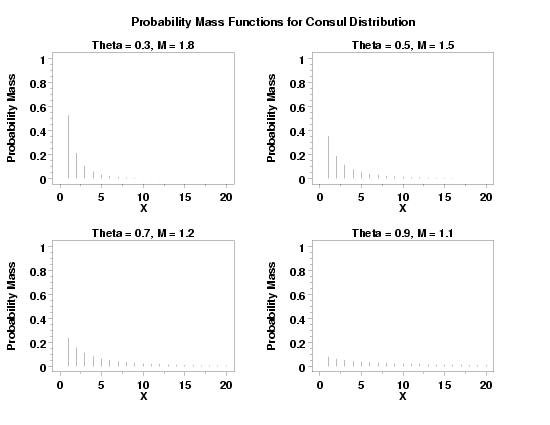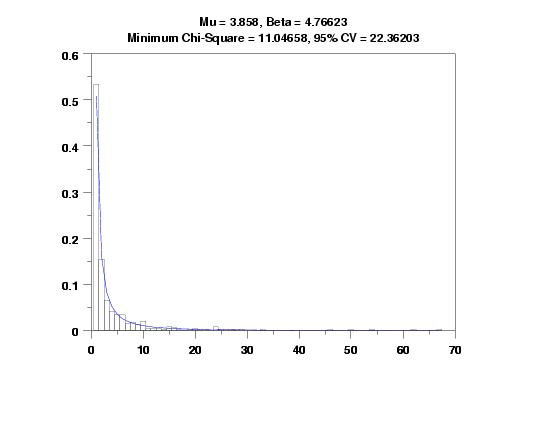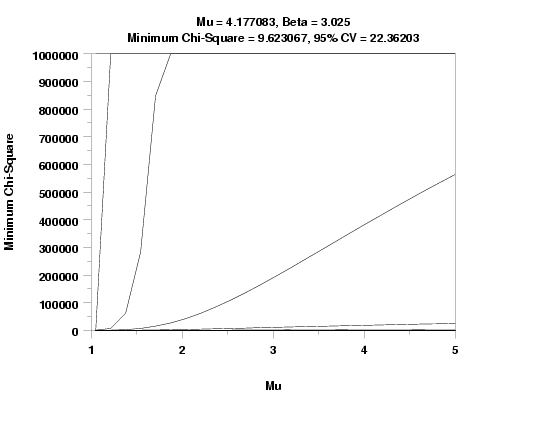

|
CONPDFName:

with The mean and variance of the Consul distribution are:

The Consul distribution is also parameterized in terms of
its mean,


For this parameterization, the mean and variance are:

Dataplot supports both parameterizations (see the Note section below).
<SUBSET/EXCEPT/FOR qualification> where <x> is a positive integer variable, number, or parameter; <shape> is a number, parameter, or variable that specifies the valuie of theta (or mu); <m> is a number, parameter, or variable that specifies the second shape parameter; <y> is a variable or a parameter (depending on what <x> is) where the computed Consul pdf value is stored; and where the <SUBSET/EXCEPT/FOR qualification> is optional.
LET Y = CONPDF(X,0.3,1.6) PLOT CONPDF(X,0.3,1.6) FOR X = 1 1 20
To restore the THETA parameterization, enter the command
LET THETA = <value> (or LET MU = <value>) LET M = LET Y = CONSUL RANDOM NUMBERS FOR I = 1 1 N
CONSUL PROBABILITY PLOT Y
CONSUL CHI-SQUARE GOODNESS OF FIT Y To obtain the method of moment estimates, the mean and ones frequency estimates, and the maximum likelihood estimates of mu and beta, enter the command
CONSUL MAXIMUM LIKELIHOOD Y2 X2
The moment estimates of

with
The method of ones frequency and sample mean estimate
of

The estimate of m is the solution of the equation:

with
The maximum likelihood mean estimate of

The estimate of m is the solution of the equation:
![(m*xbar - xbar + 1)/(m*xbar) -
EXP{-((1/(n*xbar))*SUM[x-2 to k][SUM[i=0 to x-2][x*n(x)/(m*x - i)]]}](eqns/conml2.gif)
You can generate estimates of
LET THETA2 = <value> or
LET MU2 = <value>
LET M2 = <value> CONSUL KS PLOT Y CONSUL KS PLOT Y2 X2 CONSUL KS PLOT Y3 XLOW XHIGH CONSUL PPCC PLOT Y CONSUL PPCC PLOT Y2 X2 CONSUL PPCC PLOT Y3 XLOW XHIGH
The default values of theta1 and theta2 are 0.05 and 0.95,
respectively. The default values for mu1 and mu2 are 1 and 5,
respectively. The default values for m1 and m2 are
1.05 and 5, respectively. Note that when the
Due to the discrete nature of the percent point function for discrete distributions, the ppcc plot will not be smooth. For that reason, if there is sufficient sample size the KS PLOT (i.e., the minimum chi-square value) is typically preferred. However, it may sometimes be useful to perform one iteration of the PPCC PLOT to obtain a rough idea of an appropriate neighborhood for the shape parameters since the minimum chi-square statistic can generate extremely large values for non-optimal values of the shape parameters. Also, since the data is integer values, one of the binned forms is preferred for these commands.
Famoye (1997), "Generalized Geometric and Some of its Applications", Journal of Mathematical Sciences, 8, pp. 1-13. Consul (1990), "New Class of Location-Parameter Discrete Probability Distributions and Their Chaacterizations", Communications in Statistics--Theory and Methods, 19, pp. 4653-4666.
set consul definition theta
title size 3
tic label size 3
label size 3
legend size 3
height 3
x1label displacement 12
y1label displacement 15
.
multiplot corner coordinates 0 0 100 95
multiplot scale factor 2
label case asis
title case asis
case asis
tic offset units screen
tic offset 3 3
title displacement 2
y1label Probability Mass
x1label X
.
ylimits 0 1
major ytic mark number 6
minor ytic mark number 3
xlimits 0 20
line blank
spike on
.
multiplot 2 2
.
title Theta = 0.3, M = 1.8
plot conpdf(x,0.3,1.8) for x = 1 1 20
.
title Theta = 0.5, M = 1.5
plot conpdf(x,0.5,1.5) for x = 1 1 20
.
title Theta = 0.7, M = 1.2
plot conpdf(x,0.7,1.2) for x = 1 1 20
.
title Theta = 0.9, M = 1.1
plot conpdf(x,0.9,1.1) for x = 1 1 20
.
end of multiplot
.
justification center
move 50 97
text Probability Mass Functions for Consul Distribution

Program 2:
SET CONSUL DEFINITION MU
LET MU = 4.2
LET M = 2.2
LET Y = CONSUL RANDOM NUMBERS FOR I = 1 1 500
.
LET Y3 XLOW XHIGH = INTEGER FREQUENCY TABLE Y
CLASS LOWER 0.5
CLASS WIDTH 1
LET AMAX = MAXIMUM Y
LET AMAX2 = AMAX + 0.5
CLASS UPPER AMAX2
LET Y2 X2 = BINNED Y
.
CONSUL MLE Y
RELATIVE HISTOGRAM Y2 X2
LIMITS FREEZE
PRE-ERASE OFF
LINE COLOR BLUE
PLOT CONPDF(X,MUML,MML) FOR X = 1 1 AMAX
LIMITS
PRE-ERASE ON
LINE COLOR BLACK
LET MU = MUML
LET M = MML
CONSUL CHI-SQUARE GOODNESS OF FIT Y3 XLOW XHIGH
CASE ASIS
JUSTIFICATION CENTER
MOVE 50 97
TEXT Mu = ^MUML, M = ^MML
MOVE 50 93
TEXT Minimum Chi-Square = ^STATVAL, 95% CV = ^CUTUPP95
.
LABEL CASE ASIS
X1LABEL Mu
Y1LABEL Minimum Chi-Square
CONSUL KS PLOT Y3 XLOW XHIGH
LET MU = SHAPE1
LET M = SHAPE2
CONSUL CHI-SQUARE GOODNESS OF FIT Y3 XLOW XHIGH
JUSTIFICATION CENTER
MOVE 50 97
TEXT Mu = ^MU, M = ^M
MOVE 50 93
TEXT Minimum Chi-Square = ^MINKS, 95% CV = ^CUTUPP95

CHI-SQUARED GOODNESS-OF-FIT TEST
NULL HYPOTHESIS H0: DISTRIBUTION FITS THE DATA
ALTERNATE HYPOTHESIS HA: DISTRIBUTION DOES NOT FIT THE DATA
DISTRIBUTION: CONSUL (GENERALIZED GEOMETRIC)
SAMPLE:
NUMBER OF OBSERVATIONS = 500
NUMBER OF NON-EMPTY CELLS = 17
NUMBER OF PARAMETERS USED = 2
TEST:
CHI-SQUARED TEST STATISTIC = 12.56680
DEGREES OF FREEDOM = 14
CHI-SQUARED CDF VALUE = 0.439119
ALPHA LEVEL CUTOFF CONCLUSION
10% 21.06414 ACCEPT H0
5% 23.68479 ACCEPT H0
1% 29.14124 ACCEPT H0

CHI-SQUARED GOODNESS-OF-FIT TEST
NULL HYPOTHESIS H0: DISTRIBUTION FITS THE DATA
ALTERNATE HYPOTHESIS HA: DISTRIBUTION DOES NOT FIT THE DATA
DISTRIBUTION: CONSUL (GENERALIZED GEOMETRIC)
SAMPLE:
NUMBER OF OBSERVATIONS = 500
NUMBER OF NON-EMPTY CELLS = 17
NUMBER OF PARAMETERS USED = 2
TEST:
CHI-SQUARED TEST STATISTIC = 12.12600
DEGREES OF FREEDOM = 14
CHI-SQUARED CDF VALUE = 0.403815
ALPHA LEVEL CUTOFF CONCLUSION
10% 21.06414 ACCEPT H0
5% 23.68479 ACCEPT H0
1% 29.14124 ACCEPT H0
Date created: 8/23/2006 |